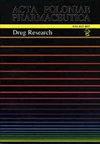In silico and in vivo investigation of the neuroprotective benefits of Ketamine against isoflurane-induced cognitive impairment
IF 0.4
4区 医学
Q4 PHARMACOLOGY & PHARMACY
引用次数: 0
Abstract
Ketamine, a phencyclidine derivative, is most usually used to induce dissociative general anesthesia, but it is also beneficial for bronchospasm, a congenital cardiac disease with the right to left shunting, and, more recently, treatment of resistant depression. Several studies have revealed that ketamine may help damaged neurons recover. Ketamine has been proven to offer neuroprotection in a variety of neuro injury models. Following that, many routes and targets were identified to demonstrate how ketamine may protect the brain. Ketamine has been shown to modulate neuronal excitotoxicity, apoptosis, and inflammation, among other things. The present work examined the relative interaction of ketamine with potential targets of brain excitotoxicity, apoptosis, and inflammation using an in-silico approach. Furthermore, ketamine has been shown to protect against isoflurane-induced cognitive impairment in rats.氯胺酮对异氟醚诱导的认知障碍的神经保护作用的体内和计算机研究
氯胺酮是一种苯环利定衍生物,最常用于诱导游离性全身麻醉,但它也有利于支气管痉挛,一种先天性心脏病右向左分流,最近,治疗难治性抑郁症。几项研究表明,氯胺酮可能有助于受损神经元的恢复。氯胺酮已被证明在各种神经损伤模型中提供神经保护。随后,许多途径和目标被确定,以证明氯胺酮如何保护大脑。氯胺酮已被证明可以调节神经元兴奋性毒性、细胞凋亡和炎症等。本研究使用计算机方法研究氯胺酮与脑兴奋毒性、细胞凋亡和炎症的潜在靶点的相对相互作用。此外,氯胺酮已被证明可以防止异氟醚引起的大鼠认知障碍。
本文章由计算机程序翻译,如有差异,请以英文原文为准。
求助全文
约1分钟内获得全文
求助全文
来源期刊
CiteScore
0.80
自引率
0.00%
发文量
74
审稿时长
6-12 weeks
期刊介绍:
The international journal of the Polish Pharmaceutical Society is published in 6 issues a year. The journal offers Open Access publication of original research papers, short communications and reviews written in English, in all areas of pharmaceutical sciences. The following areas of pharmaceutical sciences are covered: Analysis, Biopharmacy, Drug Biochemistry, Drug Synthesis, Natural Drugs, Pharmaceutical Technology, Pharmacology and General.
A bimonthly appearing in English since 1994, which continues “Acta Poloniae Pharmaceutica”, whose first issue appeared in December 1937. The war halted the activity of the journal’s creators. Issuance of “Acta Poloniae Pharmaceutica” was resumed in 1947. From 1947 the journal appeared irregularly, initially as a quarterly, then a bimonthly. In the years 1963 – 1973 alongside the Polish version appeared the English edition of the journal. Starting from 1974 only works in English are published in the journal. Since 1995 the journal has been appearing very regularly in two-month intervals (six books a year). The journal publishes original works from all fields of pharmacy, summaries of postdoctoral dissertations and laboratory notes.

 求助内容:
求助内容: 应助结果提醒方式:
应助结果提醒方式:


